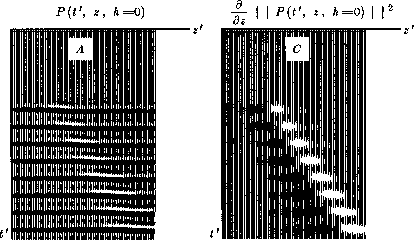




Next: Decomposing a gather by
Up: STACKING AND VELOCITY ANALYSIS
Previous: In and out of
In the 15 continuation
equation
continuation
equation  , scaling the depth z is
indistinguishable from scaling the velocity.
Thus, downward continuation with the wrong velocity
is like downward continuation to the wrong depth.
Stephen M. Doherty [1975] used this idea
in a velocity-estimation scheme--see Figure 8.
, scaling the depth z is
indistinguishable from scaling the velocity.
Thus, downward continuation with the wrong velocity
is like downward continuation to the wrong depth.
Stephen M. Doherty [1975] used this idea
in a velocity-estimation scheme--see Figure 8.
doherty
Figure 8
Two displays of the (z,t)-plane at zero offset.
The earth model is eight uniformly spaced reflectors
under a water layer (a family of hyperboloids in (h,t) at z=0).
The left display is the zero-offset trace.
The amplitude maximum at the focus is not visually striking,
but the phase shift is apparent.
The right display is the z-derivative of the envelope
of the zero-offset trace.
A linear alignment along z' =vt' is more apparent.
(Doherty)

The idea is to downward continue with a preliminary
velocity model and to display the zero-offset trace,
a function of t', at all travel-time depths  .If the maximum amplitude occurs at
.If the maximum amplitude occurs at  ,then your preliminary model is good.
If the maximum is shifted, then
you have some analysis to do before you can say what velocity
should be used on the next iteration.
,then your preliminary model is good.
If the maximum is shifted, then
you have some analysis to do before you can say what velocity
should be used on the next iteration.





Next: Decomposing a gather by
Up: STACKING AND VELOCITY ANALYSIS
Previous: In and out of
Stanford Exploration Project
10/31/1997
![]() continuation
equation
continuation
equation ![]() , scaling the depth z is
indistinguishable from scaling the velocity.
Thus, downward continuation with the wrong velocity
is like downward continuation to the wrong depth.
Stephen M. Doherty [1975] used this idea
in a velocity-estimation scheme--see Figure 8.
, scaling the depth z is
indistinguishable from scaling the velocity.
Thus, downward continuation with the wrong velocity
is like downward continuation to the wrong depth.
Stephen M. Doherty [1975] used this idea
in a velocity-estimation scheme--see Figure 8.

![]() .If the maximum amplitude occurs at
.If the maximum amplitude occurs at ![]() ,then your preliminary model is good.
If the maximum is shifted, then
you have some analysis to do before you can say what velocity
should be used on the next iteration.
,then your preliminary model is good.
If the maximum is shifted, then
you have some analysis to do before you can say what velocity
should be used on the next iteration.